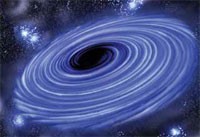Black Holes, Holograms, and the Nature of Reality

By Robert Marshall
Most people do not usually stop to think how strange we see and experience the Universe. I can see you and you can see me. Yet our eyes are only sensitive to a very small portion of all light in the Universe. People exist on the surface of a celestial ball that rotates on its axis and revolves around a star. Yet we feel no motion. And the atoms that make up each of our living cells are made up of mostly empty space. Yet we appear to be solid. What is real? The lesson here is our minds are limited in their understanding of the nature of reality.
Recently, astrophysicists made a startling discovery in pursuing the quest to figure out our bizarre Universe. Their findings spawned from an equally bizarre idea pertaining to black holes and matter. Black holes — once only theory — are known to exist at the centers of most galaxies and elsewhere, and are the end of the road for massive stars. After burning all of its nuclear fuel, a star, which is at least eight times the mass of our sun, has potential to not only explode, but leave behind a core so dense that no force can hold it up any longer. The result is an infinite mass whose gravitational pull is so strong, not even light can escape!
For decades it had been believed that matter could be lost forever in the infinite, unobtainable depths of a black hole. To many, this was a concept to argue with. How can matter go from existing to not existing? Today, there is a complicated and very puzzling mathematical solution to this dilemma. After falling in, matter, and the information it carries, might be stored on the surface of the black hole — kind of like a hologram.
And this theory can be taken a step further. If information and matter can be stored on the surface of black holes, then maybe the information and matter in everyday, ordinary lives is stored on the surface of the Universe. Who knows, we might all just be holograms...
Classroom Discussion
- Why do we not feel the motion of the Earth?
- Mass determines all properties, including the life span, of a star. Research other outcomes for the death of stars